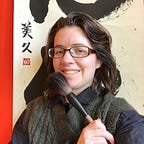Which Japanese Camera Company is Named after the Buddhist Goddess of Mercy?
The culture behind the names of five famous Japanese companies
Mitsubishi. Kikkoman. Nintendo. Many Japanese companies are household names in the West.
This article looks at the intriguing background behind the names of five of the most globally successful Japanese brands.
Read on to find out which company names were influenced by samurai heraldry, out-of-date kanji, mythological creatures, and the Buddhist goddess of mercy.
1. Mitsubishi (三菱)
The world-famous Mitsubishi three-diamond logo holds the clue to the origins of the company’s name.
The logo is a combination of two mon (紋). These are traditional family crests which are similar to European heraldic coats-of-arms.
The two mon which inspired the Mitsubishi logo are:
1. A stack of water chestnut leaves. This is the mon of Yatarō Iwasaki, the founder of Tsukumo Shokai, the precursor to Mitsubishi.
2. Three oak leaves in a symmetrical three-spoked design, the mon of the Yamanouchi family, of the Tosa clan that ruled over Iwasaki’s birthplace.
Water chestnuts are known as hishi, sometimes rendaku’d to bishi. Due to its diamond-shaped leaves this word also refers to a diamond shape, in much the same way that “diamond” has come to mean the shape as well as the jewel.
As Japanese language learners will know, mittsu or mitsu means “three”.
The two mon combine to create a symmetrical three-spoked design of diamond-shaped water chestnut leaves: Mitsubishi.
You can find out more on Mitsubishi’s Wikipedia page. The official website of Mitsubishi Electric has a pictorial explanation of the combination of the two mon.
2. Kikkoman (キッコーマン)
What’s the kanji for “ten thousand”?
If you said 万, you’re correct.
If you said 萬, you’re also correct. This is the original version of 万. It is still used occasionally, in situations where a traditional feel is desired.
Both the original and modern version are pronounced man.
As well as “ten thousand”, it can also refer to any unspecified large number, similar to the English words “hundreds” or “thousands”.
A stylised version of this old-fashioned man 萬 kanji appears inside the hexagon on the Kikkoman bottle label:
This hexagon shape represents a tortoise shell, a symbol of success and longevity in Japan.
“Tortoise shell” = kikkō
“Hundreds” = man
So “Kikkōman” = “Hundreds of tortoise shells”, a fitting name for a very successful and well-established company.
You can read more about the Kikkoman logo here, and the company’s history here.
3. Sony (ソニー)
Originally named Tokyo Tsushin Kogyo, Sony was renamed when it entered the international market. The founders wanted a name which could be romanised and would be easy for English-speakers to remember.
According to Wikipedia, “Sony” is mix of the Latin word sonus meaning “sound” and the English word “sonny”, the American English slang term for a boy.
Like many English loan words which have been adopted by Japan, the meaning changed somewhat upon entering the Japanese vocabulary. In 1950s Japan, sonny specifically referred to smart and well-dressed young men, which Sony’s founders considered themselves to be.
4. Nintendo (任天堂)
You might have heard that “Nintendo” translates as something like “leave luck to heaven” or “to put one’s fortune in the hands of fate”.
This Kotaku article suggests a different interpretation: the kanji 天 (ten), whilst meaning “heaven”, is actually a reference to the tengu (天狗), the bird-like creature of Japanese mythology. Fittingly, these creatures are associated with gambling and playing cards, Nintendo’s original products.
Nintendo even produced packs of traditional hanafuda playing cards under the name of “Tengu”. There is an image of a modern replica of these on the official Nintendo website (about 2/3 of the way down the page).
Continuing this line of reasoning, if we take 任 (nin) to mean “to allow someone to do”, and 堂 (dō) as “temple” or “hall”, 任天堂 could mean “the place that is allowed to sell playing cards”.
A further theory (also stated in the Kotaku article linked above), put forward by the famous Tokyo Vice author Jake Adelstein, is that the 任 (nin) is a reference to gangsters, who were originally associated with (often illegal) card games.
5. Canon キヤノン
Originally named Seikikōgaku Kenkyūsho, the first camera this company made was called the Kwanon, an old-fashioned spelling of Kannon, the bodhisattva of mercy and compassion. (Translated into English Kannon is often referred to as a “goddess”, as in the title of this article, although this is not strictly correct).
Kannon is one of the most famous and beloved bodhisattvas in Japan; you can find images of her at temples all over the country. Sensōji, the well-known temple in Asakusa, Tokyo, is dedicated to her, and is also known as Asakusa Kannon (浅草観音). The famous 100-metre (300-feet) statue in Sendai is called 大観音 (dai-kannon), literally “Big Kannon”.
Canon’s original logo featured her image:
Looking to rename itself post-World War II, the company took inspiration from their first camera and changed their name to Canon Camera Co., Inc.
You can find more information on the name and history of Canon on the official company website.
So that’s five Japanese companies whose names have a uniquely Japanese heritage. Understanding the history behind the names reveals how even in modern times, respect for traditional culture lives on through Japanese corporate values and ideals, and is exported around the world in the shape of good quality, innovative products.
Do you know any company names with interesting back stories?
